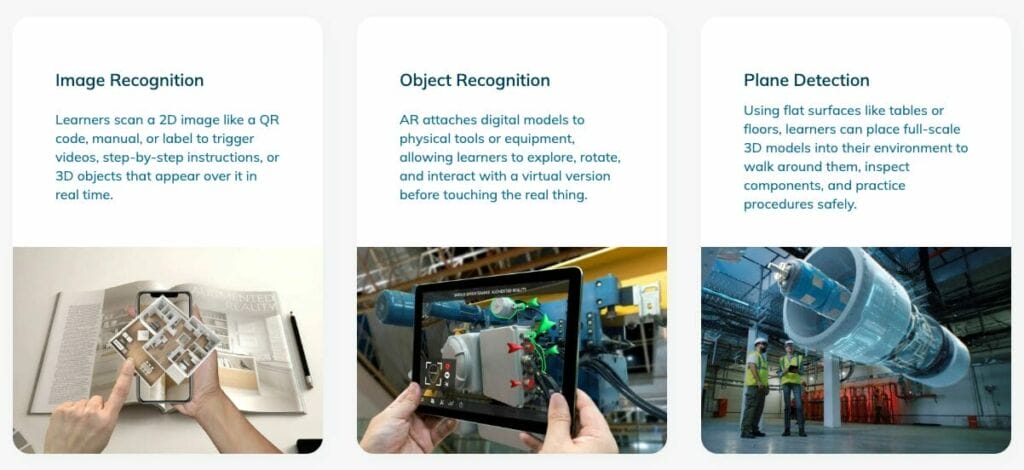Here’s a reality check: 70% of consumers now regularly use augmented reality, according to recent industry data. But adoption doesn’t equal success. As AR training becomes mainstream across healthcare, manufacturing, and retail sectors, organizations face significant hurdles that can derail implementations.
The augmented reality market is projected to reach $597 billion by 2030, growing at 40.9% annually. Despite rapid adoption, organizations must navigate several key augmented reality challenges to maximize their AR training investment.
At Roundtable Learning, we’ve helped dozens of organizations implement successful AR training programs. This article breaks down the 5 most common augmented reality problems and delivers proven solutions to solve them. Understanding these challenges is critical for successful implementation in 2025 and beyond.
Table of Contents
What Is Augmented Reality Training?
Augmented reality training overlays digital content—3D models, instructions, data visualizations—onto the real world through smartphones, tablets, or AR glasses. Unlike VR, which creates fully immersive digital environments, AR overlays digital information onto the real world, allowing learners to stay connected to their physical workspace.
The technology relies on three core capabilities: image recognition, plane detection, and object recognition. Learn more in our article on The Big Three AR Technologies: Image Recognition vs. Plane Detection vs. Object Recognition.

Today, AR training reduces onboarding time by up to 75% and enhances work quality by 30-40%. Modern AR solutions work on standard mobile devices, though AR glasses like Magic Leap 2 offer hands-free alternatives for industrial environments.
Key Benefits Of Augmented Reality Training
Safe experiential learning with high learner engagement: AR training allows employees to practice complex procedures risk-free. Research from PwC shows that VR and AR learners are 275% more confident applying skills compared to traditional methods. Learners make mistakes without real-world consequences, accelerating skill development while maintaining safety.
Dynamic in-the-moment performance support: AR supports employees during actual work. Boeing reported a 25% reduction in production time after implementing AR work instructions for aircraft assembly, with technicians completing tasks faster and with fewer errors.
Easy to reuse and distribute at scale: Deploy training to thousands of employees across locations without travel costs. Organizations report reducing training time by 75%—from 8 hours to just 2 hours per employee.
Reduced training costs and faster ROI: While initial development requires investment, AR training delivers substantial long-term savings. Companies typically see ROI within 12-18 months, with cost savings accelerating as the training library expands.
5 Problems With Augmented Reality And Their Solutions
1. Creating “Cool Tech” Instead Of Effective Training
The Problem: The biggest mistake is developing AR applications because the technology is novel, not because it solves a real training problem. AR isn’t appropriate for all scenarios. It excels at spatial, hands-on tasks but struggles when forced onto soft skills training, theoretical concepts, or purely knowledge-based content.
Applied in a Lifelike Scenario: A Fortune 500 company spent $200,000 developing AR compliance training to showcase technology at a conference. The training covered workplace harassment policies—content with zero spatial components. Completion rates were 30% lower than the previous instructor-lead version because AR added a technology component without value. The program was scrapped after six months.
The Solution: Start with the learning objective, not the technology. Conduct a thorough training needs analysis before choosing AR. Ask: Does this task benefit from spatial visualization? Will learners apply skills in a physical environment where AR provides contextual support?
Technology alone won’t make training better—it’s the intentional design that benefits learners. If you can clearly identify a pain point that AR specifically solves (complex equipment operation, precise assembly, spatial navigation), AR may be your answer. If not, choose modalities that fit better.
2. Treating AR As A Universal Solution
The Problem: Organizations assume that because AR works for one application, it’ll work for everything. AR problems emerge when companies force every training need into an immersive format without evaluating fit.
Applied in a Lifelike Scenario: A manufacturing company successfully implemented AR for CNC machine operation, achieving 40% fewer errors. Leadership then mandated AR for all training, including leadership development and communication skills. They invested $400,000 developing AR modules for topics with no spatial component. Learner satisfaction dropped 35%. The ROI was negative—modules cost more than traditional methods while delivering worse outcomes.
The Solution: Evaluate each training need independently. AR is ideal for equipment operation, assembly procedures, navigation, safety procedures in complex environments, medical procedures requiring spatial awareness, and real-time performance support in physical spaces.
AR is not ideal for soft skills training, abstract policy training, pure knowledge transfer, theoretical concepts, or human interaction practice.
Consider blended approaches. Use AR for hands-on, spatial components and e-learning for knowledge transfer. Learn more about microlearning approaches. Ask: “How does AR reinforce learning in ways other modalities cannot?” Without a clear answer, reconsider.
3. Neglecting Content Distribution Infrastructure
The Problem: Companies overlook how they’ll distribute AR content to thousands of employees and manage updates at scale. AR requires device management, app deployment, version control, and remote updates. Without proper infrastructure, AR training becomes a logistical nightmare.
Applied in a Lifelike Scenario: A retail chain developed AR product knowledge training for 5,000 associates across 200 stores. They had no system for remotely installing the app. They shipped devices to headquarters for manual installation—three months and $80,000 in costs. Six months later, they needed updates. Without proper management, both options (ship devices back or send IT to each store) cost more than original development. The program was abandoned.
The Solution: Implement an Extended Reality Management System or Mobile Device Management (MDM) platform before deploying at scale. Solutions like ArborXR or ManageXR enable remote deployment, monitoring, and updates without physical device access.
Build infrastructure planning into your strategy from day one. How will you deploy to 100 devices? 1,000? Handle updates? Track completion? Troubleshoot remotely? Answer before development begins.
4. Designing AR Without Considering Its Constraints
The Problem: AR overlays information on the real world rather than replacing it—both a strength and limitation. Problems with augmented reality arise when designers don’t account for this positioning and fail to design intentionally for AR’s use cases.
For on-the-job support, AR must be instantly accessible. For 3D modeling, it needs reliable performance in varied lighting. For guided procedures, it must provide clear instructions without overwhelming field of view or creating hazards.
Applied in a Lifelike Scenario: An industrial equipment manufacturer developed AR training for maintenance procedures on large turbine systems. In the development lab, they designed detailed 3D models at a comfortable viewing scale on tablets. The models looked perfect at 12 inches from the screen.
On the factory floor, reality hit hard. The actual turbines were 15 feet tall. When technicians held tablets at arm’s length to overlay AR instructions on the massive equipment, the 3D models appeared tiny and illegible. Technicians had to choose between holding devices uncomfortably close to see details (losing sight of the actual equipment) or stepping far back to see both the model and turbine (making the AR instructions too small to read). The scale mismatch made the training virtually unusable. Completion rates were 60% lower than video-based training. The company abandoned the AR program after eight months and $180,000 in development costs.
The Solution: Design AR specifically for intended environments. For performance support, keep interfaces minimal and voice-activated. Ensure information appears when and where needed without searching menus.
Test in actual work environments. Consider noise, lighting, safety equipment, space constraints, and whether hands need to be free. Use high-contrast visuals for varied lighting. Implement voice commands for hands-free operation. Keep text minimal—AR excels at showing, not telling.
Consider hybrid approaches: VR for initial skill development, then AR for on-the-job application. This leverages each modality’s strengths.
5. Underestimating Ongoing Maintenance Requirements
The Problem: Topics perfect for AR—complex equipment operation, spatial procedures, technical maintenance—require frequent updates. Equipment upgrades, procedure changes, and regulatory shifts demand content revisions. Organizations budget for development but not maintenance. Outdated AR training can be dangerous when training on obsolete procedures.
Real-World Impact: A medical device company invested $150,000 in AR training for surgical equipment setup. Error rates dropped 60%. Eighteen months later, the manufacturer released an updated model. The AR training became obsolete. The vendor quoted $65,000 and 14 weeks for updates. With no effective training option, they reverted to instructor-led training at multiple sites, costing $120,000 while AR updated. Delayed sales team training cost an estimated $200,000.
The Solution: Plan for content lifecycle management before development begins. Partner with a vendor like Roundtable Learning that you know you can rely on.
Build content with modularity so updates to one procedure don’t require rebuilding entire modules. This dramatically reduces update costs and timelines. Consider implementing an Extended Reality System (XRS) that allows in-house updates without vendor intervention for minor changes.
Establish quarterly content reviews. Create feedback mechanisms for end users to report inaccuracies. Document everything thoroughly with version control and change logs.
Budget realistically: plan to spend 15-20% of initial development costs annually on maintenance for rapidly evolving content.
How To Overcome AR Training Challenges: Best Practices
While the challenges of augmented reality may seem daunting, organizations can succeed by following proven best practices.
Start With a Pilot Program: Don’t roll out AR training organization-wide immediately. Select one high-impact use case with clear success metrics. Plan for 3-6 months of pilot testing to identify AR problems before scaling.
Invest in User Training and Change Management: Technology resistance is real. Provide hands-on AR device training before launching content. Communicate the “why” behind AR training and identify departmental champions who can provide peer support.
Choose Content Strategically: Prioritize high-stakes procedures where errors have serious consequences. Select frequently used procedures that benefit from performance support. Focus on procedures involving physical equipment or spatial relationships.
Plan for Scalability: Choose technology platforms that scale efficiently. Standardize device selections across the organization. Build content libraries with reusable assets rather than one-off modules.
Measure and Iterate: Track completion rates, knowledge retention, and on-the-job performance metrics. AR learners typically show 90% retention rates compared to 10% for traditional lecture-based training. For guidance, read: How To Measure Training ROI.
Partner With Experienced Vendors: Evaluate vendors based on both technical capabilities and instructional design expertise. Review industry-specific experience—vendors familiar with your sector understand your challenges and regulations.
Future-Proof Your Investment: Choose platform-agnostic development approaches. Plan for device evolution and stay informed about emerging AR standards. Maintain detailed documentation of all AR assets for easier transitions.
Conclusion
Augmented reality training delivers measurable results—reduced training time, improved learning outcomes, and better on-the-job performance—but only when organizations address its challenges directly. The problems with augmented reality are real but solvable.
Success requires strategic planning, careful vendor selection, ongoing content management, and realistic expectations about AR’s capabilities. Organizations that treat AR as one tool in a comprehensive training toolkit see the strongest results.
The augmented reality challenges outlined here—technical issues, content limitations, vendor risks, immersion trade-offs, and maintenance requirements—don’t diminish AR’s value. They define the path to successful implementation. Companies that acknowledge and plan for these challenges build sustainable AR training programs that deliver long-term ROI.
AR training success comes from matching the right technology to the right learning challenge, supporting users through adoption, and maintaining content quality over time. Get those elements right, and AR training transforms from a costly experiment into a competitive advantage.
Ready to explore how AR training can solve your specific challenges? Schedule a meeting with our team or initiate the design process to discuss your training needs and discover whether AR is the right fit for your organization.









